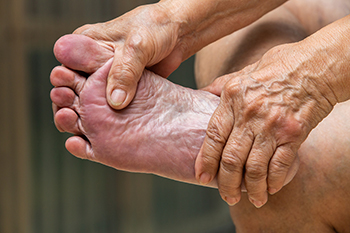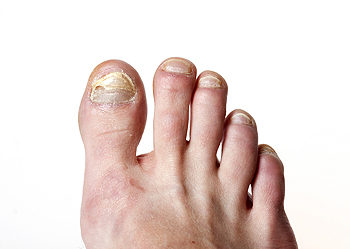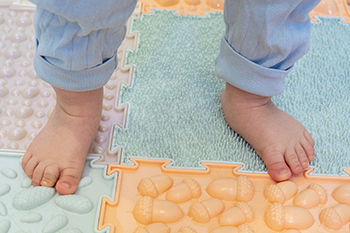August 2024
Elderly and their Feet
While proper foot care is important for everybody, senior citizens have the tendency to be more susceptible to certain foot conditions. The elderly should therefore be well informed about any problems that may arise and about what they can do to properly avoid or treat them.
Some of the most common foot problems seniors are susceptible to include foot ulcers, ingrown toenails, fallen arches, and fungal nails. A foot ulcer is an open sore on the foot and can be a result of diabetes and decreased sensation in the feet. An ingrown toenail is defined as when the nail grows into the side of the toe. Fallen arches are indicated by the instep of the foot collapsing. A fungal nails is a condition that results in deformed and discolored toenails.
In order to avoid these conditions it is recommended that the feet be inspected by the patient on a regular basis. If these inspections are carried out routinely, there is a good likelihood that problems can be identified before they become severe, or can even be avoided altogether. If any abnormality is discovered, it is important that the individual consult a podiatrist for diagnosis and information on treatment options.
Proper foot hygiene is also important. Making sure that you always have clean, dry socks on can be a major deterrent to many different problems including bacterial infections, foot odor, and certain types of fungus. Wet feet are a major cause of many of these problems. If your socks get wet, it is important to change them. Walking around in wet socks may not only lead to various infections, but can irritate the skin and result in a number of various complications. Clean, dry feet are less likely to be affected by fungal and other infections.
As people age, the fat present on your feet begins to deteriorate. The protective nature of this fat keeps the feet healthy by providing a barrier between your bones and the ground. This also aids in giving the skin on the feet a certain amount of elasticity. This is one factor that causes elderly people to develop some serious foot issues. Foot moisturizers can be helpful to avoid certain problems associated with this. However, water-based moisturizers do not work as well for elderly people as they do for the young. Instead, it is more effective to use an emollient instead. An emollient is effective because it binds the water in the foot, keeping it from becoming absorbed too readily which will result in dry skin. Emollients also have a special property called occlusion, which provides a layer of oil on the skin. This layer prevents the foot from drying up and can be very effective in treating dry skin disorders. If you can keep the skin on your feet healthy, this will substantially reduce the number of foot problems you will encounter in old age.
Proper footwear is another way to keep feet healthy. Shoes that fit well and provide proper support help prevent ingrown toenails and fallen arches.
Certain medical conditions such as diabetes or poor blood circulation increase the risk for foot issues. For individuals with any of these conditions it is extremely important to conduct regular foot inspections to make sure that there are no sores or infections present.
How Aging Impacts Foot Health

As people age, their feet often experience significant changes that can lead to various issues. Dry skin is a common problem, as decreased moisture and thinner skin can lead to cracking and discomfort. Flat feet may develop or worsen, as the arch tends to flatten over time due to weakened ligaments and tendons. Hammertoe is another prevalent condition where the toes become bent and rigid, causing pain and difficulty in walking. Additionally, the Achilles tendon can shorten and become less flexible with age, leading to heel pain and limited mobility. To manage these issues, it is important to keep feet moisturized, choose supportive footwear, and perform stretching exercises to maintain flexibility. If you are elderly or are caring for a senior citizen, it is suggested that you schedule regular appointments with a podiatrist who can treat any foot condition, and monitor foot health.
Proper foot care is something many older adults forget to consider. If you have any concerns about your feet and ankles, contact Brian D. Jackson, DPM from Neuhaus Foot and Ankle. Our doctor can provide the care you need to keep you pain-free and on your feet.
The Elderly and Their Feet
As we age we start to notice many changes in our body, but the elder population may not notice them right away. Medical conditions may prevent the elderly to take notice of their foot health right away. Poor vision is a lead contributor to not taking action for the elderly.
Common Conditions
- Neuropathy – can reduce feeling in the feet and can hide many life-threatening medical conditions.
- Reduced flexibility – prevents the ability of proper toenail trimming, and foot cleaning. If left untreated, it may lead to further medical issues.
- Foot sores – amongst the older population can be serious before they are discovered. Some of the problematic conditions they may face are:
- Gouging toenails affecting nearby toe
- Shoes that don’t fit properly
- Pressure sores
- Loss of circulation in legs & feet
- Edema & swelling of feet and ankles
Susceptible Infections
Diabetes and poor circulation can cause general loss of sensitivity over the years, turning a simple cut into a serious issue.
If you have any questions please feel free to contact one of our offices located in Columbia and Pulaski, TN . We offer the newest diagnostic and treatment technologies for all your foot and ankle needs.
How to Treat Your Toenail Fungus
While not a serious issue, toenail fungus, or onychomycosis, can be an embarrassing and uncomfortable condition to experience. Toenail fungus is often caused from public areas that harbor fungi and improper cleaning/drying of the foot. Once infected, the fungus grows deeper into the nail and can be very hard to get rid of.
There are different types of fungus that cause toenail fungus. Dermatophytes, yeasts, and molds are the most frequent forms of fungus to infect the toenail. Dermatophytes are the most common among the three. Symptoms associated with fungal nails include the discoloration of the toenail, brittleness, and in some circumstances, a smell. Pain is rarely a symptom caused by toenail fungus.
Diagnosis of fungal nails is generally a rather quick process. However podiatrists will make sure that the cause is not another condition such as lichen planus, psoriasis, onychogryphosis, or nail damage. Podiatrists will make use of fungal cultures and microscopy to verify that it is fungus.
While over-the-counter ointments are readily available, most are ineffective. This is due to the fact that the nail is very protective and that the fungus slips in between the nail plate and bed. Podiatrists can offer oral medication which currently provides the best results.
Ultimately, prevention is the best line of defense against toenail fungus. Avoid unsanitary public showers. If you do use a public shower, use shower shoes to provide your foot with protection. Once you are finished showering, make sure to thoroughly dry your feet. Fungi thrive in warm, dark, and moist places like sweaty, warm feet that are left dark in shoes all day.
Facts About Fungal Toenails

Fungi, which reside on the body, can thrive over time in or on the toenail. This can result in an infection known as onychomycosis, or fungal toenail. You can also pick up onychomycosis through contact with someone who has it. Additionally, this fungal infection can be transmitted through contact with toenail clippers, nail files, or pedicure instruments at a salon where fungi are present. Older adults whose drier nails make it easier for fungi to enter the nail are more prone to developing fungal toenail infections. Additionally, people who wear fake nails, use public swimming pools, or have diabetes or a weakened immune system may be successiptble to developing toenail fungus. People whose feet are confined to warm, moist environments where fungi thrive are also more at risk of developing fungal nails. Fungal nail symptoms include brittle, thickened, discolored or distorted nails, which can sometimes be accompanied by odor or pain. While some people try to treat fungal toenail infections at home, the fungi can be very stubborn and resilient. If you have toenail fungus, It is suggested that you schedule an appointment with a podiatrist to address the issue and prevent it from recurring.
If left untreated, toenail fungus may spread to other toenails, skin, or even fingernails. If you suspect you have toenail fungus it is important to seek treatment right away. For more information about treatment, contact Brian D. Jackson, DPM of Neuhaus Foot and Ankle. Our doctor can provide the care you need to keep you pain-free and on your feet.
Symptoms
- Warped or oddly shaped nails
- Yellowish nails
- Loose/separated nail
- Buildup of bits and pieces of nail fragments under the nail
- Brittle, broken, thickened nail
Treatment
If self-care strategies and over-the-counter medications does not help your fungus, your podiatrist may give you a prescription drug instead. Even if you find relief from your toenail fungus symptoms, you may experience a repeat infection in the future.
Prevention
In order to prevent getting toenail fungus in the future, you should always make sure to wash your feet with soap and water. After washing, it is important to dry your feet thoroughly especially in between the toes. When trimming your toenails, be sure to trim straight across instead of in a rounded shape. It is crucial not to cover up discolored nails with nail polish because that will prevent your nail from being able to “breathe”.
In some cases, surgical procedure may be needed to remove the toenail fungus. Consult with your podiatrist about the best treatment options for your case of toenail fungus.
If you have any questions, please feel free to contact one of our offices located in Columbia and Pulaski, TN . We offer the newest diagnostic and treatment technologies for all your foot care needs.
Three Grades of Ankle Sprains
An ankle sprain occurs when one or more ankle ligament gets overly stretched. Ligaments are strong bands of tissue that bind and support the bones and other structures that make up the ankle. In more severe ankle sprains, the ligament(s) tear—either partially or completely—and there may be an audible popping noise at the moment of injury.
Ankle sprains are quite common and can occur when the ankle rolls outwardly (eversion) or inwardly (inversion), causing the ligament(s) to stretch beyond normal limits, or even tear. Falls, twists, or blows to the ankle during sports or other activities can cause this injury, as well as wearing improper footwear, running on uneven surfaces, or having weak ankles.
Depending on the injury’s severity, an ankle sprain will be classified as Grade I, Grade II, or Grade III. Grade I sprains involve ligament(s) being overly stretched but not torn, with symptoms of mild pain, swelling, and ankle instability. There may also be some difficulty bearing weight. A Grade II sprain usually involves a partial tear of the ligament which brings more intensity in these symptoms, along with possible bruising. With a Grade III sprain, the ligament is completely torn, the symptoms are severe, and it may not be possible to put weight on the affected foot at all.
To diagnose and grade an ankle sprain, a podiatrist will perform a physical examination, checking for tenderness and range of motion in the ankle. For more severe sprains, X-rays or other imaging studies may be necessary.
It is vitally important to have an ankle sprain treated properly as improper healing often leads to future ankle sprains and possibly even chronic ankle stability. Treatment for an ankle sprain will vary, depending on its severity, and may include the RICE method (Rest/Ice/Compression/Elevation), physical therapy, bracing, medications, and possibly even surgery to repair a torn ligament. Rehabilitation is very important for the sprain to heal properly and to restore functionality.
What is a High Ankle Sprain?
 A high ankle sprain, also known as a syndesmotic sprain, involves injury to the ligaments connecting the tibia and fibula above the ankle joint. Unlike common ankle sprains affecting the ligaments on the outer side of the ankle, high ankle sprains result from a twisting or rotational force, often occurring during sports involving sudden changes in direction. Symptoms include pain above the ankle, swelling, bruising, and difficulty in bearing weight. Diagnosis typically involves a physical examination and imaging tests like X-rays or MRI scans to assess the extent of ligament damage and to ensure there are no associated fractures. Treatment typically starts with rest, compression, and elevation. Severe cases may require immobilization with a cast or boot and, in some instances, surgery to repair torn ligaments. Recovery can be longer than a typical ankle sprain, ranging from several weeks to a few months, depending on the severity and treatment approach. If you believe you may have endured a high ankle sprain, it is suggested that you schedule an appointment with a podiatrist for a proper diagnosis and treatment.
A high ankle sprain, also known as a syndesmotic sprain, involves injury to the ligaments connecting the tibia and fibula above the ankle joint. Unlike common ankle sprains affecting the ligaments on the outer side of the ankle, high ankle sprains result from a twisting or rotational force, often occurring during sports involving sudden changes in direction. Symptoms include pain above the ankle, swelling, bruising, and difficulty in bearing weight. Diagnosis typically involves a physical examination and imaging tests like X-rays or MRI scans to assess the extent of ligament damage and to ensure there are no associated fractures. Treatment typically starts with rest, compression, and elevation. Severe cases may require immobilization with a cast or boot and, in some instances, surgery to repair torn ligaments. Recovery can be longer than a typical ankle sprain, ranging from several weeks to a few months, depending on the severity and treatment approach. If you believe you may have endured a high ankle sprain, it is suggested that you schedule an appointment with a podiatrist for a proper diagnosis and treatment.
Ankle sprains are common but need immediate attention. If you need your feet checked, contact Brian D. Jackson, DPM from Neuhaus Foot and Ankle. Our doctor can provide the care you need to keep you pain-free and on your feet.
How Does an Ankle Sprain Occur?
Ankle sprains take place when the ligaments in your ankle are torn or stretched beyond their limits. There are multiple ways that the ankle can become injured, including twisting or rolling over onto your ankle, putting undue stress on it, or causing trauma to the ankle itself.
What Are the Symptoms?
- Mild to moderate bruising
- Limited mobility
- Swelling
- Discoloration of the skin (depending on severity)
Preventing a Sprain
- Wearing appropriate shoes for the occasion
- Stretching before exercises and sports
- Knowing your limits
Treatment of a Sprain
Treatment of a sprain depends on the severity. Many times, people are told to rest and remain off their feet completely, while others are given an air cast. If the sprain is very severe, surgery may be required.
If you have suffered an ankle sprain previously, you may want to consider additional support such as a brace and regular exercises to strengthen the ankle.
If you have any questions please feel free to contact one of our offices located in Columbia and Pulaski, TN . We offer the newest diagnostic and treatment technologies for all your foot and ankle needs.
How to Care for Your Child's Feet
It is never normal for a child to experience pain in his or her feet. Foot pain that lasts more than a few days and limits a child’s ability to walk should be examined by a podiatrist. Many adult foot ailments originate in childhood and may be present at birth. Common foot issues that are experienced by children are pediatric flat foot, Sever’s disease, ingrown toenails, and plantar warts.
A child’s foot grows rapidly during the first year, allowing it to reach almost half of their adult foot size. Consequently, foot specialists consider the first year to be the most crucial point in the foot development process. There are ways you can help ensure that your child’s foot develops properly. One way is to carefully look at your baby’s feet. If you notice any deformities, you should immediately seek professional care. You should also loosely cover your child’s foot, since tight coverings may prevent movement and inhibit normal development. Another tip is to change the baby’s positioning throughout the day. If your baby lies down in one spot for too long, it may put an excess amount of strain on the feet and legs.
It is best that you try not to force a child to start walking. Children will begin to walk when they are both physically and emotionally capable to do so. You should also avoid comparing your child’s walking progress with other children because the age range for independent walking may range. When your child’s feet begin to develop, you may need to change both their shoe and sock size every few months to allow room for their feet to grow.
Kids are sometimes prone to splinters, cuts, and severe injuries because they tend to walk around barefoot. This also makes them more susceptible to developing plantar warts which is a condition caused by a virus that invades the sole of the foot through breaks in the skin. These ailments can be avoided by making sure your child wears shoes in unsanitary environments. You should also wash any minor cuts or scrapes on your child’s feet. It is a myth that exposure to fresh air will heal injuries; fresh air will only expose your child’s cuts to germs.
As a parent, you should ensure that your child’s feet are developing properly and are being properly maintained. Consequently, it is important that you perform routine inspections on his or her feet to detect any injuries or deformities in their early stages. Early detection and treatment will help to ensure that your child does not develop any serious foot conditions.
Managing Children’s Flat Feet
 Flat feet, or pes planus, in children, is a condition where the arches of the feet do not develop properly, resulting in the entire sole touching the ground. Often, this condition is flexible, with the arch appearing while sitting or standing on tiptoe, but disappearing when standing flat. Causes include genetics, ligament laxity, or underlying conditions like cerebral palsy. Children with flat feet often experience overpronation, where the ankles roll inward excessively. Overpronation can be mild, moderate, or severe, based on the degree of inward roll. Many children experience no symptoms and often outgrow flat feet as their arches develop naturally, usually by age six. However, some may experience pain, fatigue, or difficulty with physical activities requiring intervention. Rarely, severe cases may require surgical treatment. If your child is experiencing discomfort from flat feet, it is suggested that you schedule an appointment with a podiatrist who can provide recommendations which may include wearing supportive footwear, orthotic inserts, or stretching exercises to strengthen foot muscles and improve posture.
Flat feet, or pes planus, in children, is a condition where the arches of the feet do not develop properly, resulting in the entire sole touching the ground. Often, this condition is flexible, with the arch appearing while sitting or standing on tiptoe, but disappearing when standing flat. Causes include genetics, ligament laxity, or underlying conditions like cerebral palsy. Children with flat feet often experience overpronation, where the ankles roll inward excessively. Overpronation can be mild, moderate, or severe, based on the degree of inward roll. Many children experience no symptoms and often outgrow flat feet as their arches develop naturally, usually by age six. However, some may experience pain, fatigue, or difficulty with physical activities requiring intervention. Rarely, severe cases may require surgical treatment. If your child is experiencing discomfort from flat feet, it is suggested that you schedule an appointment with a podiatrist who can provide recommendations which may include wearing supportive footwear, orthotic inserts, or stretching exercises to strengthen foot muscles and improve posture.
The health of a child’s feet is vital to their overall well-being. If you have any questions regarding foot health, contact Brian D. Jackson, DPM of Neuhaus Foot and Ankle. Our doctor can provide the care you need to keep you pain-free and on your feet.
Tips for Keeping Children's Feet Healthy
- Make sure their shoes fit properly
- Look for any signs of in-toeing or out-toeing
- Check to see if they have Clubfoot (condition that affects your child’s foot and ankle, twisting the heel and toes inward) which is one of the most common nonmajor birth defects.
- Lightly cover your baby’s feet (Tight covers may keep your baby from moving their feet freely, and could prevent normal development)
- Allow your toddler to go shoeless (Shoes can be restricting for a young child’s foot)
- Cut toenails straight across to avoid ingrown toenails
- Keep your child’s foot clean and dry
- Cover cuts and scrapes. Wash any scratches with soap and water and cover them with a bandage until they’ve healed.
If you have any questions, please feel free to contact one of our offices located in Columbia and Pulaski, TN . We offer the newest diagnostic and treatment technologies for all your foot care needs.








